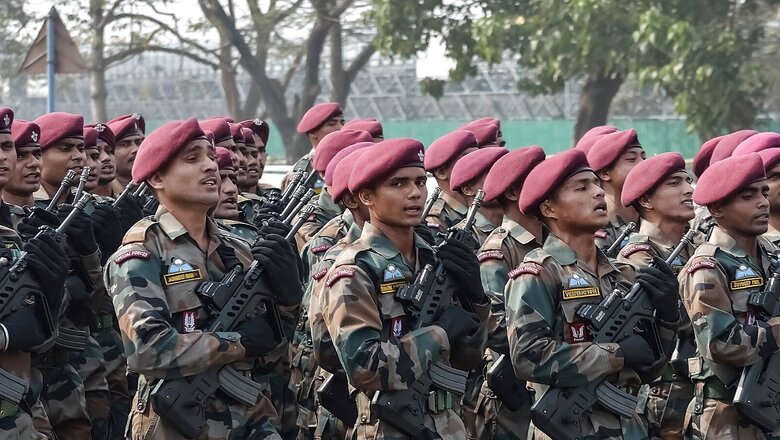
views
The introduction of the Agnipath scheme has sparked violence across the country in the name of protests. Over a dozen trains and several buses and other vehicles have been torched by mobs of purported ‘Army aspirants’. Railway stations and police stations also have not been spared by rioters who did not shy away from clashing with the police. In total, thousands of crores of rupees in public money have been blazed away in a matter of just two days. Protests were particularly violent in the states of Bihar, Telangana, West Bengal and Uttar Pradesh where violent mobs far outnumbered security personnel and wreaked havoc on the streets from the word go.
These riots have a curious nature. What started as protests took no time to morph into riots as if that was the intended plan in the first place. It is also ironic that the foundational premise of these riots is enduring patriotism and the wish to serve in the nation’s military. Let us defend the nation at its borders or we will burn it down, is what the message seems to be here. Not an ideal variant of patriotism, but some enjoying the unrest unfolding may have already likened it to the passion of a jilted lover.
Of course, it would be naive to think that the large mobs sprung out organically. Political parties and much of the anti-government activist class have an apparent hand in the unrest we are witnessing today. In fact, the political and activist clique which could not care less about the military and those aspiring to be in it, has seized the opportunity to pull a fast one against their long-standing enemies in the government. Their desired end is another rollback and hence, another political setback for the Modi government, regardless of the merits of the scheme and the constructive intentions behind it. That is why even a defence-related reform that would only boost India’s firepower is being dragged into the political battlefield to score a point against the government.
The Agnipath scheme launched by the government would revolutionise the way India recruits its soldiers, curb the ballooning pension bill of the armed forces and bring in young blood. Youngsters would be recruited between the ages of 17.5 and 21, and will serve for four years below the rank of commissioned officers, after which 25% would be absorbed by the forces for permanent service while the rest of them would be relieved of their duties with a tax-exempted corpus of 11 to 12 lakh rupees apart from the salary drawn over their four years of service, among a host of other benefits including those in the aspect of education. This is a radical idea in the Indian context, but similar policies are followed around the world from the US to China. It’s what helps keep internal costs at bay and allows militaries to modernise and acquire adequate firepower, apart from having a younger force at the frontiers.
Keeping in mind that recruitment was halted for two years owing to the pandemic and that some candidates were already halfway into the selection process before the freeze, the government has relaxed the upper age limit by 2 years as a one-time waiver for the year. The Home Ministry has also decided to reserve 10% vacancies in CAPFs and Assam Rifles for the Agniveers. 10% reservations have been announced in the Indian Coast Guard, Defence Public Sector Undertakings (DPSUs) and defence civilian posts. More such modifications could be on their way as the government frantically deliberates on the matter.
These modifications are welcome, but they did not require mass-scale riots and arson on the streets. Granted, the reform is a grievous assault on the age-old obsession with government jobs, ‘Sarkari Naukris’ beyond which no Indian can tread without risks, playing up this emotional attachment of the public has its political benefits— it always has. That’s why it is so hard to privatise white elephants masquerading as PSUs or to impose accountability in public offices. Out of India’s 900 million-strong workforce, the Indian public sector employs less than 3% of them, so it should be clear that government jobs cannot remain an earth-shattering fixation.
Moreover, of all government jobs, the defence sector falls into a whole different category. It is not all about employment and job security when it comes to serving in the military, and it should not be so for anyone misunderstood so far. The military does not just need young blood and modernised firepower, but it also needs a wider pool of motivated youth to make permanent soldiers out of. And learning from nations that follow some or another kind of conscription policy, it is necessary that men and women with military experience are released into the system to contribute to the larger society as law-abiding, patriotic professionals with educated sensitivity towards India’s security challenges.
However, extremely creative myths are being manufactured to rile up the masses at the behest of political vested interests when it comes to Agnipath. A quick look at the faces involved in the riots would tell that many leading the charge and passing off as ‘students’ are way past the eligible age group for recruitment. Besides, leftist organisations crossed over to the other side, super enthusiastic about patriotic service in the military— a huge departure from their usual line of thought. But this is what happens when their political opponent is glued to power and has seemingly booked a victory for 2024 as well, while the rest of the opposition struggles to unite or find a credible face to challenge the might of the Prime Minister. All that remains is the street veto— hitting the streets and manufacturing a sense of misery and injustice, with the hope that a democratically elected government would fold and lose face. It’s never too hard to gather a crowd in India with a few hundred bucks for each man or just an uncanny rumour that the man would definitely eat whole without a double-check. For those reasoning that the government fell short on consensus-building, the sad reality in India remains that even after mind-numbingly prolonged discussions to enforce reform, the message would still be corrupted before it reaches the masses and street violence would remain an option as long as it is politically incentivised by the state’s weakness in dealing with it— agitations against farm laws and the Citizenship Amendment Act before it being glaring examples. Thousands of crores worth of public property are just collateral damage normalised by the sheer frequency of such riots.
The Indian state should get used to anticipating such unreasonably heightened proportions of violence given the political environment which can be best characterised as a decadent, bottomless discourse, with an aversion for democracy, and a wolfish urge to take down the incumbents in New Delhi by any means possible. India pays a high price for seeking reforms— first by sitting idle, battling internally with the bureaucratic snailery, then by losing public property to lawless goons and if luck truly, completely runs out, a rollback would be announced while the rest of us can wait for the next cycle to begin some other time.
Read all the Latest News , Breaking News , watch Top Videos and Live TV here.

















Comments
0 comment